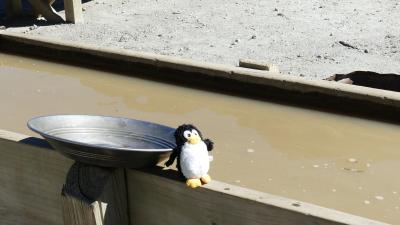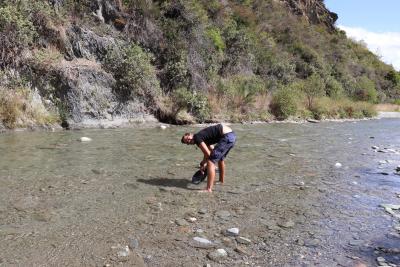Dienstag, 20. Februar 2018
Goldiges Wochenene / golden weekend
Samstag war mal wieder tolles Wetter und ich wollte etwas unternehmen. Ein Trip über Nacht war aber etwas zu spontan. Also besuchte ich die Goldfields-Mine ca. 35 Minuten mit dem Auto von Queenstown. Dort kam ich gerade rechtzeitig für die letzte Tour des Tages an, die ich natürlich buchte.
Wir erfuhren allerhand über die Geschichte der Goldgräberei in der zweiten Hälfte des 19. Jahrhunderts (ab ca. 1860). Die Männer hatten es ziemlich schwer. Sie kamen zu Fuß von der wirtschaftlichen Hauptstadt der Südinsel (Te Waiponamou), Dunedin, 250 km über Berge, und im wahrsten Sinne, Stock und Stein zu den neu gefundenen Goldfeldern. Es war sehr hart, da das Land fast nur aus Fels und Gras bestand. D.h. Es gab kaum Möglichkeiten Nahrungsmittel anzubauen. Doch mit der Zeit entwickelten sich die Siedlungen und somit auch die Wirtschaft in der Region Otago. Noch heute kann man diese Siedlungen besichtigen (es lebt aber keiner mehr dort). Die Winter waren kalt und die Arbeit schwer, weil noch keine Maschinen entwickelt waren. Sie mussten das Gestein von Hand zerkleinern. Die Flüsse und Minen waren voller Gold und so lohnte sich die körperliche Arbeit. Die Männer schürften innerhalb von Tagen, kiloweise des gelben Edelmetalls. Und in der Goldfield-Mine sind noch heute funktionsfähige Maschinen von 1870 zu sehen, die auch vorgeführt wurden.
Am Ende der Führung hatten wir die Gelegenheit aus einem Haufen Kies des nahen Flusses Kawarau Gold zu waschen. Uns wurde die Technik erklärt und dann ging es los. Der eine oder andere gab schnell auf aber meine Geduld hat sich gelohnt. Ich fand ein paar Quartzsteinchem mit eingeschlossenem Gold.
Das Goldfieber hat mich gepackt und so beschloss ich Sonntagnachmittag nach Arrowtown zu fahren um dort nochmal Gold zu waschen. Ich nahm noch einen Mitbewohner mit und so liehen wir uns die Ausrüstung und los gings. Nach ca. einer Stunde wurde ich fündig. Ist zwar fast Staub aber für mich trotzdem ein Erfolg. Und ich konnte die harte Arbeit der Männer in den 1860er und 70er Jahren hautnah erleben.
...Fortsetzung folgt!

Pingu hilft / Pingu helps

Gold waschen / washing gold
As it was good weather on Saturday, I decided to do something. A trip overnight was too spontaneous. Thus I visited the Goldfields-Mine, which is about 35 minutes driving from Queenstown. I arrived just in time for the last tour of the day, which I booked.
We learned a lot about the history of mining in this area during the second half of the 19th century (as from 1860). The men had a hard time. They came from the economic capital of the South Island (Te Waipounamu), Dunedin, 250 km by foot over the mountains and literally over rough and smooth to the new gold fields. It was very hard, as the land was only made of rocks and grass, viz. they had no possabilities to cultivate food. But in time, more people came and so the economy and settlements developed in the Otago-Region. You can see this settlements to this very day (but no one lives there anymore). The winters were cold and the work hard, because there was no machinery they could use. Men had to crush the stones by hand. The rivers and the mines held heaps of gold and so the hard physical word was worth it. They dug kilos of gold within a few days.
Today, you can see functioning machinery from 1870, which is shown as well.
At the end of our tour we had the opportunity tho wash some gold by ourselves. There was a small pile of gravel from the near Kawarau-river. The techniques were explained to us, and so we started. Some gave up very early, but I was patient and it was worth it I found some Quartzstones with goldparticles in it.
The gold fever took me and so I determined to go for another gold wash in Arrowtown. I took a Housemate with me and we hired the equipment. After an hour I found something. It is almost dust but a success for me anyway. And I felt the hard physical work of the men in the 1860s and 70s.
...to be continued!
Wir erfuhren allerhand über die Geschichte der Goldgräberei in der zweiten Hälfte des 19. Jahrhunderts (ab ca. 1860). Die Männer hatten es ziemlich schwer. Sie kamen zu Fuß von der wirtschaftlichen Hauptstadt der Südinsel (Te Waiponamou), Dunedin, 250 km über Berge, und im wahrsten Sinne, Stock und Stein zu den neu gefundenen Goldfeldern. Es war sehr hart, da das Land fast nur aus Fels und Gras bestand. D.h. Es gab kaum Möglichkeiten Nahrungsmittel anzubauen. Doch mit der Zeit entwickelten sich die Siedlungen und somit auch die Wirtschaft in der Region Otago. Noch heute kann man diese Siedlungen besichtigen (es lebt aber keiner mehr dort). Die Winter waren kalt und die Arbeit schwer, weil noch keine Maschinen entwickelt waren. Sie mussten das Gestein von Hand zerkleinern. Die Flüsse und Minen waren voller Gold und so lohnte sich die körperliche Arbeit. Die Männer schürften innerhalb von Tagen, kiloweise des gelben Edelmetalls. Und in der Goldfield-Mine sind noch heute funktionsfähige Maschinen von 1870 zu sehen, die auch vorgeführt wurden.
Am Ende der Führung hatten wir die Gelegenheit aus einem Haufen Kies des nahen Flusses Kawarau Gold zu waschen. Uns wurde die Technik erklärt und dann ging es los. Der eine oder andere gab schnell auf aber meine Geduld hat sich gelohnt. Ich fand ein paar Quartzsteinchem mit eingeschlossenem Gold.
Das Goldfieber hat mich gepackt und so beschloss ich Sonntagnachmittag nach Arrowtown zu fahren um dort nochmal Gold zu waschen. Ich nahm noch einen Mitbewohner mit und so liehen wir uns die Ausrüstung und los gings. Nach ca. einer Stunde wurde ich fündig. Ist zwar fast Staub aber für mich trotzdem ein Erfolg. Und ich konnte die harte Arbeit der Männer in den 1860er und 70er Jahren hautnah erleben.
...Fortsetzung folgt!

Pingu hilft / Pingu helps

Gold waschen / washing gold
As it was good weather on Saturday, I decided to do something. A trip overnight was too spontaneous. Thus I visited the Goldfields-Mine, which is about 35 minutes driving from Queenstown. I arrived just in time for the last tour of the day, which I booked.
We learned a lot about the history of mining in this area during the second half of the 19th century (as from 1860). The men had a hard time. They came from the economic capital of the South Island (Te Waipounamu), Dunedin, 250 km by foot over the mountains and literally over rough and smooth to the new gold fields. It was very hard, as the land was only made of rocks and grass, viz. they had no possabilities to cultivate food. But in time, more people came and so the economy and settlements developed in the Otago-Region. You can see this settlements to this very day (but no one lives there anymore). The winters were cold and the work hard, because there was no machinery they could use. Men had to crush the stones by hand. The rivers and the mines held heaps of gold and so the hard physical word was worth it. They dug kilos of gold within a few days.
Today, you can see functioning machinery from 1870, which is shown as well.
At the end of our tour we had the opportunity tho wash some gold by ourselves. There was a small pile of gravel from the near Kawarau-river. The techniques were explained to us, and so we started. Some gave up very early, but I was patient and it was worth it I found some Quartzstones with goldparticles in it.
The gold fever took me and so I determined to go for another gold wash in Arrowtown. I took a Housemate with me and we hired the equipment. After an hour I found something. It is almost dust but a success for me anyway. And I felt the hard physical work of the men in the 1860s and 70s.
...to be continued!
phillipt am 20. Februar 18
|
Permalink
|
0 Kommentare
|
kommentieren
Neu
- Danke / Thank you (phillipt, 17.Jul.18)
- 7. und Letzter / 7th and last (phillipt, 17.Jul.18)
- 6. Teil / 6th Part (phillipt, 12.Jun.18)
- Tage 13 bis 15 / Days 13 to 15 (phillipt, 12.Jun.18)
- ...und weiter geht's... / ...and so on... (phillipt, 07.Jun.18)
Links
Navigation
Meta
Suche
Archiv
- Februar 2018MoDiMiDoFrSaSo234589101112131415161718192122232425262728
RSS